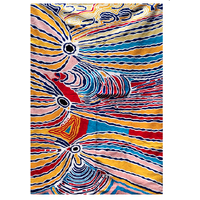Rug, Wall Hanging, S, Wool, Aboriginal, Chainstitch, Australia, Fair Trade, Marsupial Mouse, Rama Sampson, APY Lands, Living cheapest Room, Art, Home
These beautiful woollen embroideries work equally well as floor rugs and wall hangings.
Chain-stitched kilims are a traditional rug making technique from Kashmir. As people sat on the floor they were both homewares and decoration.
The designs are by Australian Aboriginal artists, they are then chain-stitched in wool onto a canvas backing each cushion cover is an interpretation of an original artwork, usually a painting.
Front of each rug is wool embroidered onto a cotton canvas and back is cotton canvas with a non-slip surface.
Each rug has a flap on one of the shorter sides for hanging portrait style, simply slide a piece of dowel or curtain rod in and hang. As the artworks are painting on the ground most of the images do not have a set orientation so can also be hung landscape if preferred.
*
These are surprisingly hard-wearing and I use them as both rugs and as beautifully textured affordable works of art.
Limited Edition: Each rug is individually numbered and shipped with an individual document of Authenticity that gives provenance. No more than 100 rugs will ever be made in this design and size.
*
Artist: Rama Kaltu-Kaltu Sampson
Title: Mingkiri Tjukurpa (Marsupial Mouse Ancestral Creation Story)
*
SIZE:
Rectangular: 61 cm (24 inches) x 91.5 cm (36 inches)
Composition: wool (front) and cotton (back)
Color: the color cheapest is accurate but more nuanced in real life
*
CARE INSTRUCTIONS:
Do not put place/use in direct sunlight or colors may fade. To clean - careful hand-wash in warm water using a wool detergent. Can be ironed on a wool setting.
*
Artist:
Rama Kaltu-Kaltu Sampson was born c. 1936 in Mt. Davis, Pipalyatjara, in the Anangu Pitjantjatjara Yankunytjatjara Lands. He is an accomplished painter and traditional ngangkari – doctor and spiritual healer. Rama painted at Ernabella for three years before coming to Adelaide. His strong knowledge of tjukurpa (dreaming) has earned him much respect and his work has been exhibited extensively across Australia. As an Anangu elder, Rama has a great wealth of traditional knowledge and skills. Rama's country is Kuntjanu, and he is custodian of the Wanampi Tjukurpa – the Rainbow Serpent Dreaming.
*
Design Story: Mingkiri Tjukurpa (Marsupial Mouse Creation Story)
Ramas painting illustrates the Mingkiri Tjukurpa the dreaming of the marsupial mice near Kuntjanu, Rama's country in remote north-western South Australia. The painting shows the many burrows where the mingkiri live. The mingkiri are digging with their mulya (noses) to block their holes. When Rama talks about the Wanampi Tjukurpa (Rainbow Serpent Dreaming), he says that many stories are all together – tjungu. The Mingkiri people cry when Wanampi is speared by a left handed man, but his son was in the womb of Wanampi's wife, so the rainbow serpent still lives today at the rockhole in Kuntjanu. The kuniya (python) and liru (snake) people are also all here, in this one big story.
*
About the BWA chainstitch kilim products
These beautiful, unique textiles are a cross-cultural collaboration combining Aboriginal designs and traditional Kashmiri rug-making techniques. Chain stitched, using hand dyed wool, each is a completely handmade piece. A more empowering way to work, this brings many direct benefits to the artists' and their community. Control and ownership of intellectual property are also maintained. Purchase of these products guarantees a direct return to the Aboriginal artist and their community.
*
About my connection wtih Better World Arts
I met founder of BWA in 2004 whilst doing a consultancy in the APY Lands preparing marketing plans for five art centres for Ananguku Arts. I was gobsmacked by this terrific fair trade project that Kaltjiti Arts was then doing with Caroline Wilson. As a textile nut, the artisan skills and use of wool appealed to me and the rendering of Indigenous designs in rugs and cushion covers is so lovely. I later encouraged them to work with other art centres and introduced them to Warlukurlangu Artists and Injalak Arts. Flick (founder of Flying Fox Fabrics)
*
BWA
Better World Arts has been operating for over two decades. Our role models were Oxfam, Fred Hollows (the Fred Hollows Foundation) and Anita Roddick (The Body Shop).
We work with traditional artisans from remote regions in Kashmir, Peru, West Bengal, Uttar Pradesh and Nepal (Tibetan refugees). More recently we have started working with China, making bone china and silk ties.
We work with Australian Aboriginal artists from remote communities across Australia, from Arnhem Land to Central and the Western Desert regions, from rural locations and from cities.





